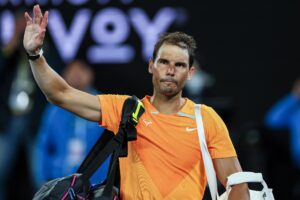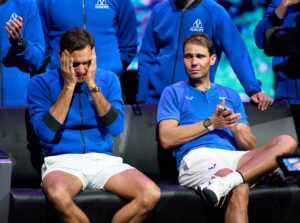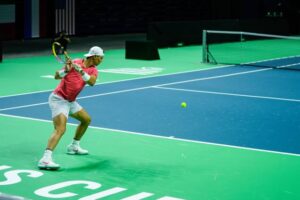Martin Keady, our resident tennis historian, looks back at Novak Djokovic’s failure to achieve the Calendar Slam, arguing that it shows just how incredibly hard that achievement is.
It says everything about how hard it is to win the Calendar Slam, especially in the Men’s game, that not one of The Big Three – Roger Federer, Rafael Nadal and Novak Djokovic – could achieve it. And Novak Djokovic’s failure last night to win the 2021 US Open men’s singles final, which meant that he failed at the very last to win all four Majors in one calendar year, surely now means that the Calendar Slam will end up as the one thing that even The Big Three could not win.
So extraordinarily resilient has Djokovic been throughout the last year that even when he was two sets and two breaks of serve down in the third set against Daniil Medvedev it was still possible to imagine that he could somehow come back and win. The reasoning went along the lines of, “If anyone can do it, Novak can”. But in the end it turned out that not even Djokovic could overcome such utterly insurmountable odds.
As was commented on widely almost immediately after Djokovic’s eventual straight-sets defeat to Medvedev, “he may not have won the match, or the Calendar Slam, but he finally won over the fans”. That much is true and as Djokovic himself said afterwards, with genuine feeling after labouring in the gigantic shadows cast by Federer and Nadal for more than a decade, it was almost a compensation for not winning the Calendar Slam.
The irony is, however, that he had already retrieved one of the breaks before Medvedev served for the match for the second time, and it was only then that the undeniably heartfelt ovation that he received from the 24,000-plus people in the Arthur Ashe Stadium, the first time he has ever received such universal adoration at a Major final, moved him to tears. Could that emotional release possibly have cost him his last chance to strike back at Medvedev? As the Amazon Prime Video commentators, Jim Courier and Tim Henman, put it: “It’s hard to return when you have tears in your eyes”.
Of course, the likelihood is that even if Djokovic had not been reduced to tears by this long-overdue and almost universal acclamation of his incredible talent and character, he would still have lost the match, such was the brilliance of Medvedev’s play and – crucially – his physical and mental freshness in comparison with the Serb. Djokovic’s five-set semifinal against Alexander Zverev had not only lasted over twice as long as Medvedev’s three-set crushing of Felix Auger-Aliassime, but had taken place afterwards, further reducing the recovery time available to him before the final. Ultimately, therefore, even “The Rubber Man” (as Djokovic has been christened, both for his resilience and his remarkable physical flexibility) hit the wall.
As Djokovic himself had often said in the build-up to the 2021 US Open, although he will hopefully have other chances to win a 21st Major and break his three-way tie with Federer and Nadal at the top of the historical rankings, he is extremely unlikely to have another chance to win a Calendar Slam. He will be 35 next May and as Federer and Nadal have already discovered, time truly wounds all heels, even those that once appeared to be equipped with wings.
Consequently, it is virtually certain now that none of The Big Three (as I have written before, “The Gigantic Three” would be more accurate, given their almost complete dominance of men’s tennis over the majority of the last two decades) will ever win the Calendar Slam. And that, if it were needed, is surely conclusive proof of just how hard it is to achieve that particular goal.
Some Djokovic fans will no doubt claim that he has already achieved it, to a large extent, with his “Nole Slam” of 2015-16, when his victory at the French Open meant that he held all four Major titles simultaneously. Crucially, however, although he won them in succession, he did not win them all in the same calendar year. Having won Wimbledon and the US Open in 2015, he had the off-season at the end of that year (even if it is only a brief one in tennis) to recharge his batteries before winning the Australian Open and the French Open in 2016. Consequently, although the “Nole Slam” was undeniably an extraordinary achievement, indeed arguably the greatest of all the achievements of The Big Three, it was still not a Calendar Slam.
A Calendar Slam is exactly what it says on the tin – a clean sweep of all four Majors in the same calendar year, with no real opportunity for rest and recuperation throughout that period. And it is such an epic test of physical, mental and even spiritual endurance that not even the current triumvirate of truly great players could manage it. Roger Federer, of course, won three Majors a year in three of the four seasons that he was at his absolute peak (2004, 2006 and 2007), but such was Rafael Nadal’s dominance of the red dirt at Roland Garros that Federer never got close to winning even the first two Majors of the year in succession, let alone all four.
Equally, for all Nadal’s absolute annexation of the French Open as his own personal kingdom of clay, his physical frailty (at least relative to the staggering ability of both Federer and Djokovic to avoid serious injury throughout most of their careers) meant that he was never really in a sufficiently enduring state of health to make an assault on all four Majors in the same 12-month period. Indeed, he only ever managed to win three Majors in a single calendar year once, in 2010, when the Australian Open, won by Federer at the start of the year, had already escaped him.
And so it had seemed that Djokovic was the only one of The Big Three who could legitimately challenge for the Calendar Slam, a clean sweep of all the Major prizes in tennis that had only ever been achieved before by two men: Don Budge (in 1938); and Rod Laver (twice, in 1962 and 1969). The fact that it proved beyond even him, despite his almost superhuman efforts this year (in particular, his somehow defeating Rafael Nadal in a French Open semifinal that was almost certainly the greatest match ever played on clay) suggests that it may just remain beyond any man ever. That is especially true now that the four Majors are played on three different surfaces (hard courts, clay and grass), unlike in the time of Budge and Laver, when three of the four Majors (Australia, Wimbledon and the US Open) were played on grass.
Djokovic’s relative “failure” also shows just how utterly remarkable Rod Laver’s achievement of winning the Calendar Slam twice – once, as an amateur, in 1962 and then again, as a professional, in 1969 – really was. Although Rocket Rod only had to excel on two different surfaces rather than three, the fact that he could achieve the fabled Calendar Slam twice in a single decade is surely the ultimate testament to his own greatness as a tennis player.
Having said that, there may be one other testament to Laver’s greatness, which is harder to quantify but arguably even more impressive. Laver, of course, was banned from playing in the Majors for nearly seven years, because he turned professional after winning his first Calendar Slam and so was banished from what was still officially an “amateur” sport. Consequently, during what would probably have been his peak physical years in his mid-twenties, he was unable to win a single Major title, let alone four in one year.
In that respect, he is comparable to another great sporting icon of the 1960s (and beyond), Muhammad Ali, who was similarly banned from his sport, albeit for completely different reasons, when he was arguably at his peak. As a result, the absolute best of Laver and Ali may never have been seen on a tennis court or in a boxing ring.
If Laver had not been banned for so long, given his previous dominance of tennis before the ban and the dominance he subsequently showed after being readmitted to the Majors, it is surely unarguable that he would have won at least one more Calendar Slam, giving him three in total. The fact that The Big Three could not manage even one between them is surely the ultimate testament to Laver’s greatness, which still arguably surpasses even that of Federer, Nadal and Djokovic.
Main photo:
Embed from Getty Images





